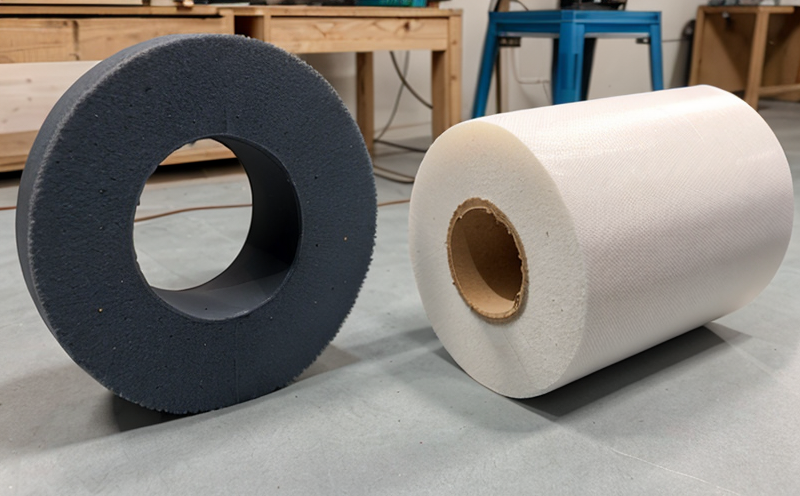ISO 9227 Salt Spray Corrosion Testing for Metallic Furniture Materials
The ISO 9227 salt spray corrosion testing is a critical process used to evaluate the resistance of metallic furniture materials against atmospheric corrosion. This test simulates the corrosive environment that might be encountered in outdoor or indoor environments, particularly in industrial and commercial settings. By subjecting metal components to controlled exposure to a saline mist, this method provides insights into how long the material can maintain its integrity before signs of corrosion appear.
The standard procedure involves placing metallic specimens within a chamber where they are exposed to a continuous spray of neutral salt solution (5% NaCl). The temperature is typically maintained between 35°C and 40°C, ensuring that the test mimics real-world conditions as closely as possible. This exposure can last for up to several hundred hours or more, depending on the specific requirements set by the manufacturer or client.
Understanding the importance of this testing in furniture manufacturing is crucial for quality managers and compliance officers who aim to ensure product longevity and customer satisfaction. For R&D engineers and procurement teams, this test plays a vital role in material selection and process optimization. The results from ISO 9227 tests help manufacturers identify materials that are most resistant to corrosion, thereby reducing maintenance costs and extending the lifespan of furniture products.
During specimen preparation, it is essential to ensure that all parts relevant for the test are included. This might involve cleaning and preparing the surface to be consistent across all samples. The process also includes marking specimens with a unique identifier and recording initial conditions such as temperature, humidity, and chloride concentration before exposure.
The equipment used in this testing ensures precision and reliability. A salt fog chamber is typically employed where the environmental parameters are strictly controlled. Inside the chamber, a continuous spray of salt solution maintains high levels of relative humidity (95% ± 3%) to enhance corrosion activity. The test is designed to provide repeatable results that can be used for quality assurance and quality control purposes.
The acceptance criteria for this testing specify that after exposure, any signs of visible rust or other forms of corrosion are noted down. A pass/fail decision is based on the extent of corrosion observed compared to pre-exposure conditions. Typically, a test passes if there is no more than 25% surface area affected by corrosion at the end of the prescribed exposure time.
Real-world applications of ISO 9227 testing are widespread across various industries, but it finds particular relevance in furniture manufacturing. By incorporating this testing into their quality assurance protocols, manufacturers can enhance product durability and meet regulatory requirements effectively. This approach not only improves customer satisfaction by ensuring high-quality products but also contributes positively to the industry’s reputation for reliability and longevity.
In summary, ISO 9227 salt spray corrosion testing is an indispensable tool in assessing the resistance of metallic furniture materials against atmospheric corrosion. Its meticulous process ensures accurate results that are crucial for quality assurance and compliance with international standards. Understanding its importance can empower stakeholders within the supply chain to make informed decisions aimed at enhancing product performance and customer trust.
Eurolab Advantages
EuroLab offers unparalleled expertise in conducting ISO 9227 salt spray corrosion testing, ensuring that manufacturers receive accurate, reliable, and consistent results. Our state-of-the-art facilities are equipped with advanced technology designed to replicate the most challenging environmental conditions, providing clients with robust data for informed decision-making.
- Comprehensive Testing Capabilities: We offer a wide range of testing services tailored to meet diverse industry needs.
- Accurate and Consistent Results: Our laboratories maintain strict adherence to international standards, ensuring that all tests are conducted under controlled conditions.
- Expertise in Interpretation: Our team comprises seasoned professionals who can provide valuable insights into the implications of test results.
We pride ourselves on delivering exceptional service and support to our clients. By choosing EuroLab, you gain access to a network of experienced experts dedicated to helping you achieve your quality assurance goals.
Why Choose This Test
- Precise Simulation: The ISO 9227 test accurately simulates the corrosive environment that furniture materials may encounter in real-world conditions, making it an essential tool for quality assurance.
- International Recognition: Adherence to this standard ensures compliance with international regulations and industry best practices.
- Predictive Value: Results from these tests help predict the longevity of furniture materials under various environmental stressors.
- Data Reliability: The consistent methodology employed in EuroLab’s facilities guarantees reliable data that can be used for informed decision-making.
The ISO 9227 salt spray corrosion test is particularly valuable for quality managers, compliance officers, R&D engineers, and procurement teams within the furniture industry. It offers a robust framework for evaluating material integrity, enhancing product durability, and ensuring regulatory compliance. By incorporating this testing into their quality assurance protocols, manufacturers can significantly improve customer satisfaction while maintaining a competitive edge in the market.
Environmental and Sustainability Contributions
The ISO 9227 salt spray corrosion test contributes positively to sustainability efforts by enabling furniture manufacturers to select materials that are more resistant to environmental degradation. This reduces waste generation, as products with enhanced durability last longer in the field, minimizing the need for frequent replacements.
- Extended Product Lifespan: By identifying and using corrosion-resistant materials, manufacturers can extend the lifespan of furniture, thereby reducing resource consumption.
- Reduced Environmental Impact: Longer-lasting products mean fewer resources are needed for production and disposal, leading to a lower carbon footprint.
- Sustainable Manufacturing Practices: The test supports sustainable manufacturing practices by providing data that helps optimize processes and material selection.
Through these contributions, ISO 9227 testing plays a crucial role in promoting environmental responsibility within the furniture industry. By enhancing product durability and reducing waste, manufacturers contribute to a more sustainable future while meeting customer expectations for quality and longevity.





